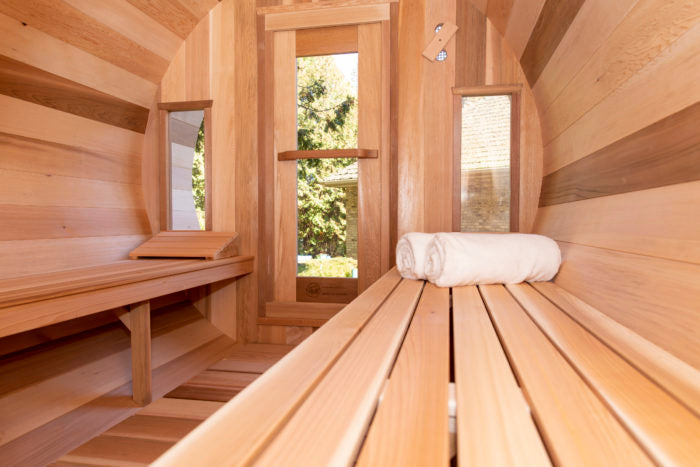The Ultimate Guide To Traditional Sauna
Wiki Article
6 Simple Techniques For Traditional Sauna
Table of ContentsTraditional Sauna Things To Know Before You Get ThisTraditional Sauna for BeginnersSome Known Questions About Traditional Sauna.Some Known Questions About Traditional Sauna.
A lot of the weight lost in a sauna is water loss and is re-gained upon rehydrating. Without a question sauna can be an essential component of a healthy and balanced weight loss program. To consider the distinctions between conventional and IR saunas, I will divide these into proven, academic, and produced distinctions.Hence, the most popular point in the saunawhich is at the ceiling directly above the sauna heateris usually in between 185 and 190 F. Traditional Sauna. Claims that a typical sauna surpasses 200 F is simply not true and not appropriate for electric saunas marketed in the United States. The temperature for a far-infrared sauna is usually established between 120 and 140 F; nonetheless, unlike the traditional sauna, the objective in and IR room is not to achieve a high temperature level
As a result of this, the temperature distinction is nearly unnecessary, considering that profuse sweating leads to both sauna kinds, yet the method of heating up the body is different. In an IR sauna the bather will really feel warm and will sweat a lot, but at a lot reduced temperatures. Hence, if the objective is to spend longer durations of time in the sauna, the IR sauna is a great choice.

The Best Guide To Traditional Sauna
When the heat is accomplished, the components cycle on and off to maintain the high temperature. The majority of traditional sauna individuals delight in pouring water over the rocks to create heavy steam to increase sauna humidity levels. The advantages of pouring water over the rocks consist of: making the area a lot more comfortable, dampening the nasal passages, and enabling the use of aromatherapy by mixing necessary oils with the water.In a far-infrared sauna, the warmth waves penetrate the body to successfully heat the body and increase the body core temperature level. To achieve this increased temperature level, Far-infrared emitters produce infrared power which is close to the same wavelength as that which the body naturally emitsoften referred to as the "Essential Variety" of 7 to 14 microns), so the power is well gotten by the body.
When the power enters the body, it creates the body temperature to increase and inevitably results in perspiration. In an infrared sauna it is essential for the emitters/heaters to remain on nearly frequently. Considering that there is no mass of rocks to maintain heat, the sauna will certainly cool if the emitters turned off.
As stated above, the sauna bather in an infrared space wishes to place himself in front of running emitters to obtain optimal benefit from the heat. The heating time for both areas can be very different, relying on just how the rooms are used. For a typical sauna, a bather must permit 30-40 mins for the room to achieve a preferred temperature level and to appropriately pre-heat the rocks.
The Ultimate Guide To Traditional Sauna
A well created sauna will usually attain a temperature of 150-160 F in about 30-40 mins. For hotter temperatures, the room may require to warmth for a longer duration.To some, 15 mins was "thrown away" while the infrared power warmed the wood panels instead than warming a body, while others find a pre-heated space to be a lot more comfy and think a raised starting temperature level is essential to begin perspiring. The size of advised usage for every area is about the very same (10-15 minutes per session); nonetheless, because of the lower air temperature levels and the capacity to really feel the results of infrared warm much faster than a anchor conventional sauna, it is not uncommon for an individual to invest a total amount of 20-30 minutes in an infrared sauna.
Conventional saunas tend to be larger (thus make use of even more electrical energy) than infrared saunas, although conventional saunas are definitely offered in one and two individual dimensions. For a two-person conventional sauna, 5x6 or 5x7 dimension is most prominent. The leading bench can easily seat two or 3 people and is likewise enough time to relax during the sauna session.


The ordinary cost per kWH of electricity in the united state is roughly $0.11, so a 4.5 kW heating system will cost approximately $.50 to run for one click to find out more hour, if the heater runs continually for one hour. Commonly a sauna heating system will compete 75% of the initial hour and 50% of subsequent hours on considering that the elements cycle once the established temperature is attained.
The Best Strategy To Use For Traditional Sauna
A 2 person far-infrared area is usually physically smaller sized than a conventional sauna, typically concerning 4' x 4' or smaller sized. The IR home heating system is usually 1.5-1.7 kW using a 120 volt 15 amp plug-in solution. Since the space can be used sooner than a sauna area, we will assume the area is used for to of an hour consisting of warm up time.Ultimately, there is a seldom reviewed difference in the social experience between the two spaces. While our society has lost some of the social benefit of the typical sauna experience, it can be really socially gratifying. From household time in the sauna, to heart-felt discussions with better halves, to sauna partiesthe typical sauna experience can result in intimate interacting socially.
Many higher end infrared rooms consist of tinted light therapy, sound find systems and full-glass fronts.
Report this wiki page